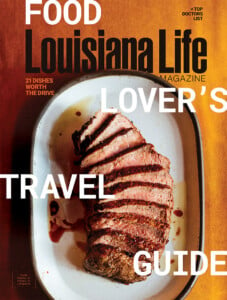How Breaux Bridge Sparked Our Crawfish Obsession

We take our state crustacean for granted, routinely imbibing crawfish at those enormous family crawfish boils or enjoying the more sophisticated crawfish étouffée or bisque in a white tablecloth restaurant.
But serving up those popular crawfish experiences wasn’t always a Louisiana tradition like it is today. Our modern intense love affair with crawfish appears to have started in Breaux Bridge.
“Mrs. Charles Hébert, the proprietress of the Hébert Hotel on South Main Street in Breaux Bridge is said to have been the first to put crawfish on her restaurant’s menu, early in the 1920s,” writes Jim Bradshaw in “Our Acadiana: A Pictorial History of South Louisiana.” “There was probably a local market for her crawfish dishes, but it was probably very local.”
In the 1930s, Bradshaw continues, a U.S. Department of Agriculture agent found the bayou crustacean to be a prime source of protein for rural Cajuns and recommended its cultivation, “but that he could not convince them to eat crawfish frequently,” Bradshaw writes.
Imagine that!
Crawfish was consumed in Louisiana before the 20th century — it’s noted in several historic texts, cookbooks and songs — but its popularity really took off in the 1940s and 50s with the advent of crawfish tails being produced commercially and advanced crawfish traps allowing for easier farming.
In April 1959, Breaux Bridge celebrated its 100th anniversary of incorporation, attracting about 50,000 visitors. That same year, the Louisiana Legislature named Breaux Bridge the Crawfish Capital of the World, so naturally crawfish was on the menu.
“Needless to say that among the thousands of people attending the Centennial Celebration, many were hungry and thirsty and that crawfish to satisfy that hunger and whatever was required to quench that thirst were served in abundance,” writes Grover Rees in “A Narrative History of Breaux Bridge, Once Called ‘La Pointe.’”
The success of that event spurred organizers to create the Breaux Bridge Festival Association and host the inaugural Breaux Bridge Crawfish Festival in early May 1960, following the conclusion of Lent. The festival once took over downtown, with crowds enjoying live music, dancing, the crowning of festival royalty and, of course, lots of boiled crawfish. Today, the three-day, first-weekend-in-May festival encompasses the more spacious Parc Hardy with 30-plus bands, crawfish vendors, crawfish eating contests, live crawfish races, arts and crafts and more.
The once governor of New France in Canada, Samuel de Champlain organized the “Ordre de Bon Temps” with his companions in 1605 in Nova Scotia, the first home of Acadians in North America. Rees attributes the Breaux Bridge Crawfish Festival as a “modern-day adaptation” of that celebration.
“However, in their festivals,” he writes about the early French Canadians, “they consumed lobsters and wine, while the celebrants of Breaux Bridge festivals use crawfish and beer.”
That’s because Louisianians discovered a good thing.
Where to Stay
There are numerous chain hotels in Breaux Bridge, most located near Interstate 10, as well as bed and breakfasts, Bayou Cabins along Bayou Teche, Bonne Terre farm retreat and several RV campgrounds.
The new kid on the block is Camp Margaritaville RV Resort Breaux Bridge at the I-10 Henderson exit, offering RV sites and cabins as well as on-site bars and restaurants, a water zone, dog park, playground and other amenities. The theme for the Crawfish Festival weekend at Camp Margaritaville is “5 O’Clock Somewhere” to coincide with Cinco de Mayo. The weekend with include special margaritas for adults and activities for the kids, plus live music Friday and Saturday.
Lafayette is only 10 miles to the west and offers a wide variety of accommodations.
If You Go
The Breaux Bridge Crawfish Festival will be May 3-5 at Parc Hardy in Breaux Bridge. Admission is $10 Friday, $15 Saturday, $5 Sunday or a $25 for a weekend pass. For more information, visit bbcrawfest.com.
